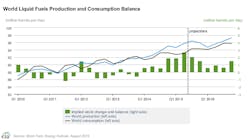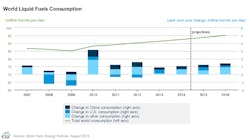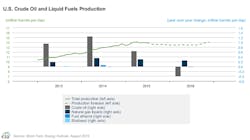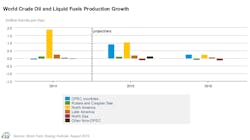EIA: US crude output declines to continue through mid-2016
Total US crude oil production declined 100,000 b/d in July compared with June, and is expected to continue decreasing through mid-2016 before growth resumes late in 2016, according to the US Energy Information Administration’s most recent Short-Term Energy Outlook (STEO).
In the outlook, EIA noted that global liquids production continues to exceed demand, resulting in strong inventory builds throughout the forecast period. Global oil inventory builds averaged 2.7 million b/d in second-quarter 2015, up 800,000 b/d from the first quarter. Inventory builds are expected to slow to roughly 1.8 million b/d in the second half of the year, and to 900,000 b/d in 2016.
Brent crude oil prices are expected to average $54/bbl in 2015 and $59/bbl in 2016, $6/bbl and $8/bbl lower than in last month’s STEO, respectively. Forecast West Texas Intermediate crude prices in both 2015 and 2016 average $5/bbl less than the Brent price.
Global oil demand
Global consumption of petroleum and other liquids will average 93.6 million b/d in 2015, unchanged from the previous month’s STEO. Growth in 2016 global consumption was revised upward by 100,000 b/d compared with last month to an average of 1.5 million b/d.
“Despite the slowdown in economic growth in the second half of 2014 and thus far in 2015, China continues to be the main driver of non-Organization for Economic Cooperation and Development (OECD) consumption growth," EIA said. "China’s consumption growth is expected to average [300,000] b/d in 2015 and 2016, below the [400,000] b/d growth in 2014.”
Total US liquid fuels consumption rose an estimated 70,000 b/d in 2014, and is forecast to grow 400,000 b/d in 2015 and 190,000 b/d in 2016. The 2016 consumption forecast is about 70,000 b/d higher than forecast in last month's STEO.
Non-OPEC production
EIA estimates that production in countries outside of the Organization of the Petroleum Exporting Countries (OPEC) grew 2.3 million b/d in 2014, mainly reflecting the growth in the US. EIA expects non-OPEC production to grow 1.4 million b/d in 2015.
US crude production is projected to increase from an average of 8.7 million b/d in 2014 to 9.4 million b/d in 2015 and then decrease to 9.0 million b/d in 2016. The forecast is 100,000 b/d lower for 2015 and 400,000 b/d for 2016 than in July's STEO. The decrease in the crude production forecast reflects a lower oil price outlook that will reduce expected oil-directed rig counts and drilling and well-completion activities throughout the forecast period.
EIA estimates that total US production was unchanged in April and began declining in May, falling 180,000 b/d from the April level. Production then declined 100,000 b/d in July compared with June.
“Oil prices, particularly in the second quarter of 2015, remained high enough to support continued development drilling in the core areas of the Bakken, Eagle Ford, Niobrara, and Permian basins, with July showing the first month-to-month increase in the oil-directed rig count since October 2014,” EIA explained.
“However, the recent fall in crude oil prices and lowered outlook for oil prices over the forecast period are expected to prolong and deepen onshore production declines,” it said. “Lower crude oil prices are anticipated to slow the rate of recovery in onshore drilling activities and well completion totals, despite continued increases in rig and well productivity and falling drilling and completion costs. The forecast remains sensitive to actual wellhead prices and rapidly changing drilling economics that vary across regions and operators.”
In particular, EIA expects US crude production declines to continue through third-quarter 2016, when total production is forecast to average 8.8 million b/d. Forecast production then returns to an average of 9.1 million b/d in the fourth quarter of that year.
“A total of 13 projects are scheduled to come online in the Gulf of Mexico in 2015 and 2016, pushing up Gulf of Mexico production from an average of 1.4 million b/d in the fourth quarter of 2014 to more than 1.6 million b/d in the same period of 2016,” EIA said.
Production growth in Canada is expected to average 300,000 million b/d in 2015 and increase to 400,000 b/d in 2016, driven by continued expansion in oil sands projects.
“Although some previously announced oil sands projects have been put on hold, the vast majority continue as planned, including Imperial Oil [Ltd.] and Cenovus [Energy Inc.] oil sand projects scheduled to come online by the end of 2016,” EIA said.
OPEC supply
According to the report, OPEC crude production will rise 800,000 b/d in 2015—led by Iraq—and remain relatively flat in 2016.
In 2016, additional OPEC crude supply is expected to come from Iran, which is forecast to boost production if international sanctions targeting its oil sector are suspended. EIA assumes sanctions relief could occur in mid-2016. If sanctions relief occurs, EIA forecasts Iranian crude supplies will increase 300,000 b/d on average in 2016, with most of the growth occurring in the second half of the year.
According to EIA, Saudi Arabia and other OPEC member countries are not expected to cut production to accommodate additional Iranian volumes, although some producers will see production declines in the near term.
“For example, Saudi Arabia’s production is expected to respond to lower direct crude burn for electric power generation as seasonal power demand abates,” EIA said. “However, there is considerable uncertainty regarding Iraq’s ability to sustain its higher production and export levels, particularly in light of infrastructure constraints in the southern terminals.”




